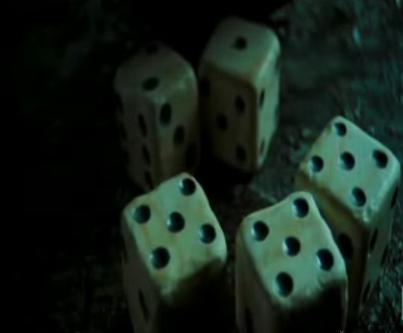This week’s assignment was to take the game Liar’s Dice
(which most people know of as the dice game from Pirates of the Caribbean: Dead Man’s Chest) and change the rules
around to get rid of and “positive feedback loop”.
Now a positive feedback loop is something within a game that:
- Destabilizes the game.
- Causes the game to end faster.
- Emphasizes actions made earlier in the game.
There are also “Negative feedback loops” that:
- Stabilize the game.
- Cause the game to last longer
- Emphasize actions made later in the game.
Our job was to identify the positive feedback loop in Liar’s
Dice and add new rules using negative feedback loops to eliminate the positive
feedback loop.
First, an outline of the rules of Liar’s Dice:
- Players: 2 - 6
- Each player starts with 5 dice and a cup.
- Players roll their dice and keep them hidden from other players.
- A one is counted as a WILD dice; it can have any value from 2 to 6.
- The first player makes a bet based on their dice and what they think the other players rolled. (ex. 6 fours)
- Each player after them must bet a higher sum than the previous bet (ex 7 fours, 6 fives etc.) until someone calls a player’s bluff.
- Bluffs can be called only on your turn and only on the person before you, after he bet.
- Once a bluff is called, all players reveal their dice.
- If it was not a bluff (i.e. There were more dice of that kind that could have been called, or exactly as many dice that were called) the player that called it a bluff loses one of their dice.
- If it was a bluff (i.e. There were not that many dice rolled) the player who bluffed loses their dice.
- Play continues until only one player remains.
The positive feedback loop in Liar’s Dice is that once a
player begins to lose dice it becomes more likely that they will continue to
lose dice. They will continue to lose dice because once one is lost they have a
smaller percentage of dice that they are able to see and use to make an
educated bet or bluff.
For example: The player loses a die --> the player has
more chances to lose --> the player loses a die --> the player has even
more chances to lose and so on...
We added mostly simple rules to eliminate the positive
feedback loop. Our rules are:
- Limit the number of players from 2-6 to 2-4 to allow less competition.
- Increase the number of dice to 7 per player.
- Adding the “house cup”. This cup has 7 dice that all players can see to add to the guessing pot. (The player must bet more than what is shown by the house cup. For example: if the house cup is showing 3 twos, 2 threes, 1 four and 1 six, then the player can call 4 twos or 3 threes etc.).
- Finally if a player only has 1 die, they can gain 2 of their dice back if they correctly catch another player’s bluff.
With the addition of these rules we had to have a few play-through's to see how the new rules affected the game play.
- This rule was just a simple rule to reduce the number of players, creating less competition for upping one another's bets. This makes it easier to place bets because the bets will not raise as quickly as they would with 6 players.
- This rule simply add more dice, making a longer game, and the ability to bet higher.
- This is a lengthy rule with a simple concept. The "house cup" allows players who have lost most of their dice to still have a general idea of what kind of bets or bluffs to make.
- Finally, this rule allows players to regain some of their lost dice. It is hard to accomplish but when it works it helps to extend the game play.
I hope everyone in class enjoys our addition to Liar's Dice. I'm not bluffing, have fun, but be careful who you challenge!
 |
| http://24.media.tumblr.com/tumblr_mbt8223QJJ1rcjxzvo1_500.gif |

No comments:
Post a Comment